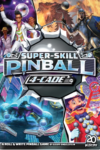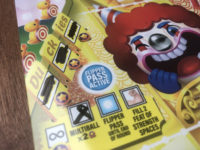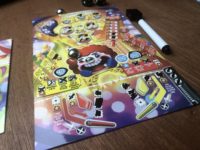- Learning time
- 10 minutes
- First play time
- 30 minutes
Super-Skill Pinball 4-Cade
Designed by: Geoff Engelstein
Super-Skill Pinball 4-Cade is roll-and-write take on the classic pinball experience: you get three ‘balls’ and try to maximise your score by hitting bumpers and targets, completing sections for bonuses and – hopefully – making each ball last as long as possible.
Each player has their own laminated board representing their pinball table with the ball starting at the top. Everyone takes turns rolling two dice, and then everyone chooses one of the dice and crosses off a matching number on it. Note that your table is affected by gravity: after each roll (unless you hit a bumper) you must drop to the next-lowest section to cross off another die there – until you reach the flippers at the bottom, where you can propel yourself back to the top again – as long as you have the correct numbers still available to cross off. If you don’t, your ball will be lost and you move on to the next one (note that players will lose balls and finish the game at different times)
Crossing off all dice in a section triggers two actions: they are all wiped clean ready to be crossed off again, and you also gain a benefit: bigger and better ways to score points or initiate special game modes such as a multi-ball play, where you assign both dice to two balls.
The game also allows you to nudge – changing a rolled die result from one you really don’t need to one you do. But there’s an inherent risk in doing so: if the next dice rolled have a differential greater than your nudge value, you ‘bust’ and lose your current ball.
Throughout the game you’re scoring points, so each player has a second board to track progress on. The box comes with four ‘tables’: Carniball, Cyberhack, Dragonslayer and Dance Fever. Each table has its own distinct ways to score, ramping up the complexity from Carniball onwards.
The guru's verdict
-
Take That!
Take That!
None - everyone plays their own game
-
Fidget Factor!
Fidget Factor!
Extremely low - everyone assigns dice at the same time, so there's not so much 'waiting for your turn' as potentially waiting for someone to make a decision, and decisions are generally pretty straightforward
-
Brain Burn!
Brain Burn!
Oftentimes - certainly on the starting board - decisions are made for you by the dice. But each table is constructed to lead you to a moment of a critical decision, albeit one that rests in fates hands.
-
Again Again!
Again Again!
The four tables are distinct, and if you enjoy what Super-Skill has to offer, the dice ensure some micro-randomness in each play, albeit they a broadly a similar experience








Sam says
I quite like roll-and-write games and the theming of Super-Skill 4-Cade attracted me, but this was a bit of a misfire for us on the table. It does a decent job of representing pinball on a page, which is some achievement, but half the experience is the management of it: every time your ball hits X spot on the table, you need to both mark it off on one board and track points on the other. When features are completed, you need to rub them out. It's very easy to forget to score, or - if you're me - find the scoring just feels like it's compromising the fun of the game with the constant interruptions. If that aspect sounds like it wouldn't be an issue for you, I think the actual pinball element is certainly a success. It was just too fiddly to be a hit on our table.